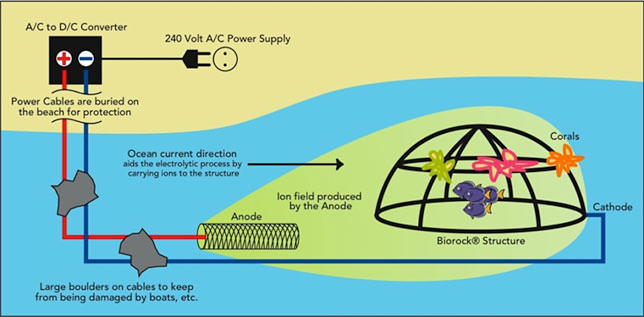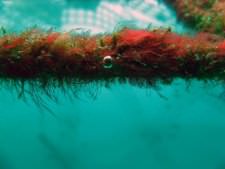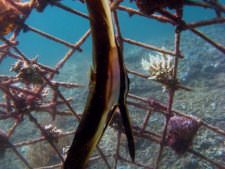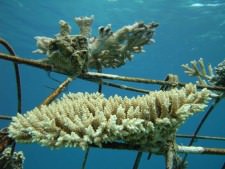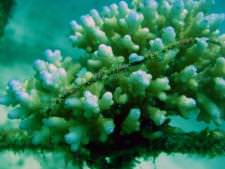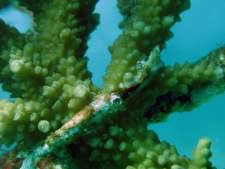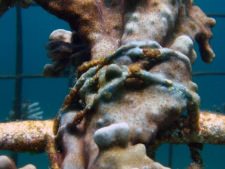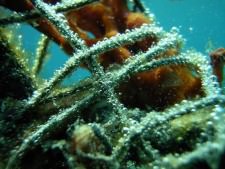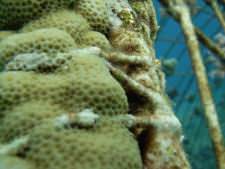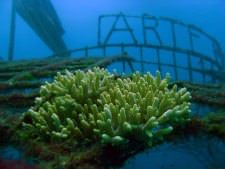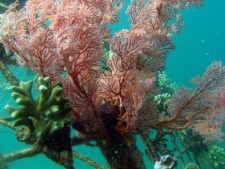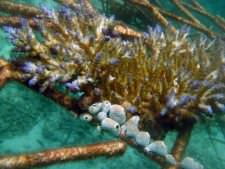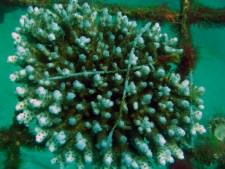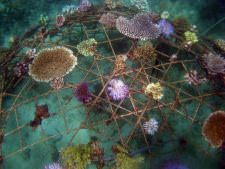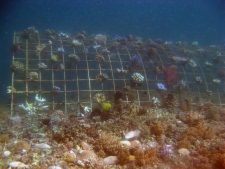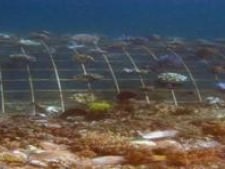Oral presentation
Arifin A Bakti – Centre for Environmental Studies, Universitas Mataram cfes_indonesia@yahoo.com
Delphine Robbe – Gili EcoTrust
Arben Virgota – Centre for Environmental Studies, Universitas Mataram cfes_indonesia@yahoo.com
Thomas J Goreau – Global Coral Reef Alliance
Abstract
Gili Trawangan is a popular diving ecotourism destination. Unfortunately a large proportion of the fringing coral reef has been damaged by global warming, natural weather action and destructive fishing practices. Despite conservation efforts now to address these problems, natural regeneration under existing efforts is inadequate, in part due to increasing global stresses. Since 2004 around 42 Biorock® structures have been installed in Gili Trawangan. Biorock® technology, invented and developed by the late Prof. Wolf Hilbertz and Dr. Tom Goreau, applies a safe low-voltage direct electrical current through seawater, causing dissolved minerals to precipitate onto steel surfaces growing white limestone/brucite minerals similar to those that make up coral reefs. Through electrolysis coral growth is accelerated and can be used to jump start an entire reef. Broken coral is collected from nearby reefs and tied onto the carbon steel structures. The additional calcium carbonate quickly cements the coral to the structure and aids its growth to an accelerated rate. These corals have much greater resistance to environmental stress such as high temperature or sedimentation, allowing reefs to be kept alive when they would otherwise die, and restore reefs rapidly in areas with little or no natural recovery. Large fish populations build up rapidly on Biorock®, allowing fisheries habitat to be restored. Biorock® shore protection structures are growing back eroded beaches on Gili Trawangan. This project has demonstrated that restoring coral growth can bring fish back. Biorock® methods speed up coral growth even where excessive temperatures, pollution, sedimentation and other stress-inducing factors have damaged reefs and other marine habitats, and have been used at many locations in Indonesia and around the world. Biorock® methods can help restore damaged coral reefs and provide building materials from sustainable energy resources for marine culture of corals, oysters, clams, lobsters and fish, thus ensure sustainability of ecotourism in the island.
Introduction
Indonesian coral reefs have the world’s richest variety of oral. There are over 3,500 marine species living in the reefs and seas of Indonesia. The Great Barrier Reef has less diversity with 1,500 species. While, the Red Sea has even less with only 600 species. Indonesia’s 17,502 islands and 85,700 sq/km of coral reef make up 14% of the coral reefs on the planet. That means the coral reefs in Indonesia are the global center of marine biodiversity on the planet. Unfortunately, only 6% of reefs in Indonesia are healthy. (Goreau, 2008). Human impacts are placing unnatural stresses on the fragile and biologically diverse coral reef ecosystems of the world. This degradation results in huge economic and cultural loss.
Gili Trawangan, Gili Meno and Gili Air are part of a marine protected area called Gili Matra. During the 1980’s they were discovered by tourists and now many people from all over the world Cheap NFL Jerseys come to relax, snorkel, scuba-dive, and enjoy this beautiful part of S.E. Asia. Every year more hotels and bungalows are being built to cope with the increasing amount of visitors, putting more and more pressure on their already limited natural resources.
The coral around the Gili islands has suffered substantial damage in previous years (mostly 1997-1998) and it was agreed that some proactive steps were necessary in order to prevent further destruction following action learning workshop (Bakti, 2003). The Gili islands are dependant on a healthy marine habitat for their fisheries, tourism, sand supply, shore protection and marine biodiversity. This habitat has been largely damaged by a combination of coral heatstroke, disease, land-based sewage, a rise in global sea level, over-fishing and direct physical damage from destructive fishing practices, boats, anchors, tourists and reef harvesting. As a result, renewable marine resources are declining, endangering local food supplies, shorelines and tourism income. Without large-scale restoration of degraded habitats to make them capable of supporting larger fish and shellfish populations, there will be fewer fish in the future and without healthy growing corals there will be fewer beaches, affecting all business owners on the island.
Restoration of our degraded reefs and coastal habitats on a scale that makes a difference must be an active environmental priority for local businesses and not an after thought. However, there is a much more serious purpose to these projects than simply ecotourism. By keeping corals alive under lethal conditions and restoring coral reefs where they cannot recover naturally, we aim to restore the reef and its fisheries, keeping ecosystems from going extinct due to global warming and to protect the shoreline from vanishing under the waves. The Gili Islands need to recover their beaches and prevent further erosion otherwise there will be serious consequences for all businesses and residents.
Methods of Biorock® Technology
The Biorock® method was invented, developed, and patented by the late Prof. Wolf Hilbertz and Dr. Thomas J. Goreau. Biorock® technology uses low voltage direct currents (above 1.2 Volts) which pass through a roll of titanium mesh, which acts as the anode, and a large steel structure acting as the cathode (Figure 1). The Biorock® process (in effect simple electrolysis) happens between these two metals, causing mineral accretion to occur, resulting in the cathode steel structure developing a solid limestone coating and the titanium anode to slowly disintegrate. As the limestone substrate develops on the cathode, other natural corals attach to it and grow. These electrical currents are safe to humans and all marine organisms. There is no limit in principle to the size or shape of Biorock® structures; they could be grown hundreds of miles long if funding allowed.
Limestone is the best substrate for hard coral. The Biorock® process is used to regenerate areas where coral reefs have been destroyed, with the resulting affect of re-populating these areas with fish and other organisms. In 2004, the Gili Eco Trust, with the support of Gili islands’ businesses, Project Aware, PADI and Global Coral Reef Alliance, started a reef restoration project using Biorock® technology. In 2004 and 2005, 5 Biorock® reefs were installed and showed positive results very quickly. In 2006, the 4th Indonesian Biorock® Training Workshop was held in Gili Trawangan with more than 30 participants and 10 new Biorock® reefs were built around Gili Trawangan, creating a new dive site for the many divers visiting the Gili islands and Lombok every year. The 6thIndonesian Biorock® training- workshop was also held in Gili Trawangan, from December 1st to 7th in 2008. More than 70 participants acquired training in the theory http://www.magliettedacalcioit.com and practice of Biorock® technology for coral reef and fisheries habitat restoration, marine culture, ecotourism and shore protection. During this workshop about 20 students from the University of Mataram participated, and were doing research projects on the impacts of biodiversity on fish populations, shore protection, and growth of corals and other organisms found on the Biorock®. 22 new Biorock® structures were constructed and situated during the workshop, joining the fifteen that had previously been installed.
Results and Discussion
Through electrolysis coral growth is accelerated and can be used to jump start an entire reef. Broken coral is collected from nearby reefs and tied onto the carbon steel structures. The additional calcium carbonate quickly cements the coral to the structure and aids its growth to an accelerated rate. These corals have much greater resistance to environmental stress such as high temperature or sedimentation, allowing reefs to be kept alive when they would otherwise die, and restore reefs rapidly in areas with little or no natural recovery. Hard and soft corals, sponges, tunicates, and bivalves were observed to grow on Biorock® materials at extraordinary rates. Hard corals on a Biorock® structure can grow 3-5 times faster than in natural conditions, the corals on the Biorock® reef are exceptionally bright colored and densely branched, heal from physical damage at least 20 times faster, have up to 50 times higher survival rate from the most severe high temperature bleaching events, and show rates of new coral growth higher than any previously recorded data.
Fish and lobster population growth in these structures is extraordinary, especially juvenile fish if the shape of the Biorock® structures is such that it provides a high density of hiding places, which they frequently do.
In Maldives, Biorock® reefs have restored severely eroded beaches by 15 meters (of beach width) in just a few years by slowing waves, so that instead of eroding sand at the shore, they deposit it (Goreau, 2008). They have been found to be stable in category 4 hurricanes and were not badly damaged during the Asian tsunami of Christmas 2004 because the open framework design allows large waves to pass through. Similarly, Biorock® shore protection structures are growing back eroded beaches on Gili Trawangan.
Conclusion
This reef restoration using Biorock® technology has demonstrated that restoring coral growth can bring fish back. Biorock® methods speed up coral growth even where excessive temperatures, pollution, sedimentation and other stress-inducing factors have damaged reefs and other marine habitats, and have been used http://www.veridianinc.com at many locations in Indonesia and around the world. Biorock® methods can help restore damaged coral reefs and provide building materials from sustainable energy resources for marine culture of corals, oysters, clams, lobsters and fish, thus ensure sustainability of ecotourism in the island.
References
Bakti, L.A.A, 2003. Introduction of Action Learning for sustainable waste management in Gili Trawangan. Working Group III Report.
Bakti, L.A.A, T. Goreau, D. Robbe, A. Virgota, 2010. “Using Community Action Planning (CAP) tools for sustainable ecotourism development in Gili Trawangan, Lombok”. Paper presented in The International Seminar on Harmonization of Tourism Development, 27 April 2010, Udayana University, Bali.
Robbe, D. 2008. How can you help to make Gili Trawangan an Eco-Example? Gili EcoTrust History. Mataram, Lombok.
Goreau, T.J, Sarkisian, T, Robbe, D, 2008. 6th Indonesian Biorock® Training Workshop in Gili Trawangan, Lombok Report.
Thomas J. Goreau,T.J, Wolf Hilbertz, & Azeez A. Hacheem, May 1998). Maldives shorelines: growing a beach. Coral Reef Alliance Report.
Some examples of the accretion process in Gili Trawangan Biorock® project (Kaddachi, 2008)
